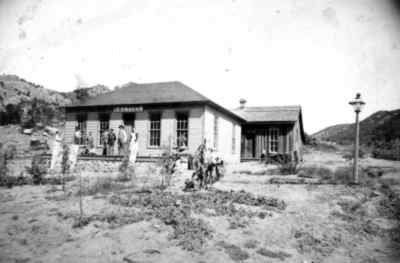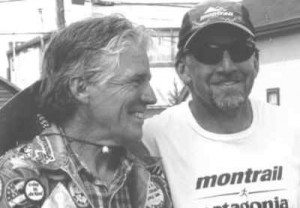Article by Nancy Oswald
Local History – February 2005 – Colorado Central Magazine
ON MAY 8, 1882 a group of Jewish Russian immigrants disembarked from the train at Cotopaxi to establish an agricultural colony. They thought they were leaving the hardships of Tzarist Russia behind, but as it turned out they were exchanging the privations of “home” for new hardships, which included non-arable land, broken promises, and the difficulty of living in a culture where language, religion, and terrain were foreign and inhospitable.
The colonists first stepped off the train in Cotopaxi with high hopes. They had been traveling for five days by train from New York to Kansas City, Pueblo, and at last the harrowing trip west through the Royal Gorge itself. At the time, Cotopaxi consisted of a few residences, a hotel and store, blacksmith shop, and a meeting house with plans in the works for further expansion.
When they arrived, the name “Saltiel” swung above the train station landing. The honor had been bestowed upon the wealthiest man in town, Emanuel H. Saltiel, by the Denver and Rio Grande railroad when the tracks were completed. The actual name of Cotopaxi had been in common use since the arrival of local miner, Henry Thomas, (Gold Tom) in the late 1870’s; after traveling and mining in South America, he was struck by the similarities of the mountains around Cotopaxi to the Ecuadorian volcano called Mount Cotopaxi, and in the end Cotopaxi is the name that stuck.
But the name hanging on the platform made little difference to the colonists. They were Yiddish speaking Hassidic Jews, who couldn’t understand the sign or (it can be hoped) the comments of the spectators. Their arrival was such a curiosity that the locals showed up at the station to watch, much like circus-goers turning out to see the freaks. According to one of the onlookers some of the locals were “openly scornful of the newcomers’ clothes, language and appearance and made no effort to conceal their hostility. Others felt sympathetic at their [the colonists’] looks of terror and awe.”

The group, when all assembled, consisted of sixty-three colonists, most of them related by marriage, intermarriage, adoption or close friendships. There were twenty-two heads of family who would be legally eligible to apply for 160-acre tracts of land under the Homestead Act. They came from the provinces of Volhynia, Kiev, and Ekaterinoslav where they had become increasingly disenchanted with the Tsarist policies which called for the unfair conscription of juveniles and prevented Jews from owning or operating farms. Many of them were already farmers by trade but found it difficult to continue that pursuit under the restraints of Tzar Alexander II.
The colonists plan to emigrate started as a seed in the late 1870’s when Saul Baer Milstein, a wealthy businessman, warehouse owner sent his nephew, Jacob to New York in order to scout out the political attitudes in America towards Jews, to find out about the Homestead Act, and locate land. In addition to this, a search was made to seek out interested relatives and friends for the eventual emigration. Saul Baer planned to sell his business in order to finance the endeavor once the appropriate arrangements were made.
Funded by his uncle, Jacob arrived in New York City in 1778 to begin his investigation, but within the first year, he broke his uncle’s trust by coaxing Saul Baer’s daughter, Yente (Nettie), to join him in America so they could be married. Saul Baer was infuriated by this. She was his oldest daughter, and he had trained Nettie and counted on her to take over much of the work in his commissions business. Immediately Saul Baer cut off the funds to his nephew, and Jacob was forced to find work in a tin factory in New York City in order to survive. This did not thwart the independent and lovesick Nettie. She refused the other suitors offered to her by the shadchen (matchmaker), and against all social and religious conventions ran away to Germany to stay with relatives until Jacob could send money for her passage.
THE MONEY FROM Jacob was not forthcoming. An accident in the tin factory caused the loss of an eye, and a lengthy recovery. It was during this recovery, in 1880, that Jacob became acquainted with Michael Heilprin a leader in the Jewish community who was instrumental in establishing the HIAS (Hebrew Immigration Aide Society). This friendship was one of the factors that eventually led to the establishment of the colony at Cotopaxi.

The second factor was a letter from Emanuel H. Saltiel, the Cotopaxi entrepreneur mentioned above, who had caught wind of the fact that Heilprin was trying to encourage immigrants to leave the urban areas and head west where the opportunities for land ownership and financial independence were greater than what was offered in the ghettos of New York City. Saltiel wrote an eloquent and convincing letter to Heilprin, offering to construct houses and barns, provide farm implements, livestock and seed for the colonists. He would keep the cost under $10,000 and all the colonists would have to raise would be living expenses and transportation costs en route to Colorado.
The deal seemed like a perfect fit. Each family would be indebted for less than $435, and because many of the Russians had experience in farming, the situation would be ideal. Heilprin sent his secretary, Julius Schwartz, to Colorado to investigate the situation and send back a report. During this time, Tsar Alexander II was assassinated, and under the new rule of Tsar Alexander III, a new set of repressive anti-Semitic laws were enacted, the worst of which were the May Laws of 1881.
THIS HAD A STRONG IMPACT on the Cotopaxi colonists. What began as a well planned and thought out move, became an urgent necessity. The colonists left Russia and were thrown into a massive wave of immigration which flooded the HIAS office with thousands of requests for aide and money for which they were totally unprepared. Because of the new urgency, the colonists arrived in New York and were sent west without ever having gotten a report back from Julius Schwartz about the living conditions at Cotopaxi.
Upon arrival in Cotopaxi, the colonists found that not all of the promises had been fulfilled. Four houses had been constructed two miles south of town on an arid plateau above Oak Grove Creek, which was both dry and sandy during the summer or roiling with water during periodic spring flooding. Eight more houses were constructed above 8,000 feet on dry rocky soil where no irrigation water could be acquired. The houses were only about eight feet square with flat roofs and lacked windows, doors and chimneys. Twenty houses had been promised, but only twelve had been constructed. The houses were unfurnished, and only four of the houses had cooking stoves.
The supplies, too, were inadequate. When asked about this, Saltiel explained that labor and building materials were in short supply and were not available locally. He said they had been sent for, but had been delayed. Shortly after that, Saltiel left on an extended business trip and was absent for several months, leaving the colonists to cope with little more than the personal belongings they had brought with them from Russia.
Because of the immediate necessity of planting their crops, the colonists decided to move into the unfinished houses.
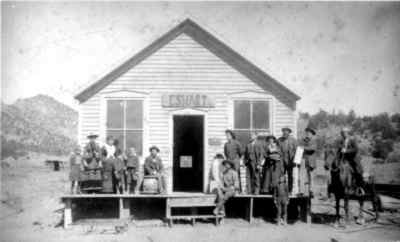
The colonists borrowed plows, horses, seed and other equipment from A.S. Hart who was in partnership with Saltiel and the co-owner of the store. The Jews were extended credit for the purchase of food and personal supplies. Rocks were cleared and crops were planted, chimneys were built, and the door-less, windowless houses were made into homes. Even then, it was near the first of June before their first crops were sown on the wind-swept slopes below the Sangre de Cristo Mountains where a “good” growing season was less than four months.
There were a few happy moments during the first summer in Cotopaxi. A Sefer Torah was donated to the colonists by the New York Orphan Asylum and the colonists were able to locate an abandoned building north of the General Store to use as a synagogue. The dedication of the synagogue on June 23rd held a mystical and divine quality, and was described with these words in an account sent to the Jewish Messenger, 1882: “The young secretary (Julius Schwartz) opened the Ark, and after the chanting of several hymns placed the Torah in its place…. Later they danced in their peculiar Russian manner and the silent moon sent its silvery rays upon the dancing and singing Russians.”
DURING THE FIRST SUMMER, two weddings were performed, one of them a religious ceremony to sanctify the marriage of Nettie and Jacob Milstein. The couple had already been married in a civil ceremony in Blackhawk where Jacob worked as a mule skinner for six months while he waited for the colonists to gather in New York and travel west. When Jacob and Nettie finally arrived at the colony, they were welcomed with open arms. They both spoke English fluently and were willing to teach the others.
Only one colonist was unhappy at the arrival of the Millsteins (now spelled with two l’s). This was Idel (Ed) Grimes who was one of the suitors who had been promised to Nettie by the matchmaker in Russia. He joined the colony and followed Nettie to America hoping to get the marriage annulled. Once his hopes were dashed, he left the colony and set out to Denver on foot, thereby making the male heads of family who were able to file on land, one less.
The singing and dancing the colonists enjoyed that summer ended abruptly when an early frost put an end to the growing season. One colonist, Morris (Zedek) Needleman had sown fifteen bags of potatoes and reaped only fourteen. Without the income from the crops, the already strapped colonists had to turn to other work to pay off their debt at the store and to provide food and clothing for the winter. Many of the men took jobs as laborers in Saltiel’s mines but saw not a penny from it. Instead they were paid in vouchers for use in Hart’s store.
In addition to the crop failure, the colonists were forced to use their winter supply of firewood for large bonfires to keep away the marauding bears. The extra houses, never having been completed, forced two families to set up camp in canvas tents and another family to spend their first year in an Indian dugout cave. During the first winter, the weather was severe, and starving Ute Indians frequently visited, begging for food.
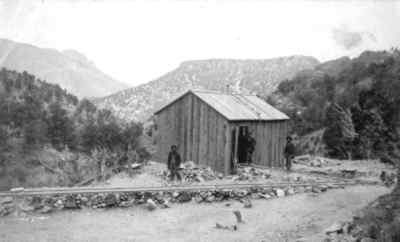
FINALLY THE MEN found work with the Denver & Rio Grande Railroad which was extending its line west from Salida over Marshall Pass. They were paid $3 a day as track laborers, carrying felled trees, three men to a tree, on their shoulders from the forest down to the site of the construction. This job held two benefits for the colonists, the first was that the railroad was happy to give them the Sabbath off in exchange for working on Sunday, and the second was that once the train firemen, conductors, and engineers learned of the colonists plight, they threw extra coal from the train along the tracks near Cotopaxi so that the women from the colony could gather it to use for heat throughout the long, harsh winter.
By the fall of 1882, it was clear that the colonists would need outside help. The promises Saltiel had made for the additional houses and supplies were never met. The colonists wrote numerous letters to the HIAS without response, and made appeals to the Jewish community in Denver who sent food, winter clothing, and medicine. At this point, the predicament of the colony became the subject of much debate. Reporters from Denver newspapers came to Cotopaxi to investigate the truth of the rumors that the colony had been mismanaged and ill-prepared.
Two completely different points of view emerged. According to Flora Satt in her master’s thesis detailing the history of the colony, the Denver Republican pinned the blame on Saltiel emphasizing his unsavory character, and they blamed the HIAS for sending the colonists into a situation which had not been fully researched ahead of time. A second newspaper, the Rocky Mountain News downplayed the situation by saying that “all pioneers must endure some hardship.” They believed the colonists were not facing anything more difficult than other settlers, and felt they were far better off than most.
The debate continued with conflicting reports, one of them from Julius Schwartz to the HIAS giving a glowing report of the colony and its success. Many reports and letters were to follow, documenting the hardships and tales of terror. One report sent to HIAS from the Denver Committee dated February 16, 1883, stated the following:

The instances of suffering among the colonists are numerous and pitiful. On one occasion the family of Morris Mimorsky was without food for two days; his wife was sick, and the Arkansas River was swollen to such an extent that it carried destruction in its terrible course. It was a question of life and death. Mimorsky plunged in the stream and, after a desperate effort, in which no other man would venture, reached the opposite shore in safety. He secured the necessary provisions for his sick wife and brought them back with him.
In a letter dated March 2, 1883, H.S. Henry from the HIAS responded with a mild reprimand:
Instead of such a report as your committee has made, a committee sent by German, Irish or Norwegian Emigrant Society would probably have encouraged the colonists by pointing out that their present discomforts were temporary, that with the return of spring and another harvest, things would improve; that perseverance after all the expenditure of money would certainly result in ultimate success…. This committee would recommend that to start life in a new country is not child’s play–that there are frequent disappointments and some misery, but that after all, success when obtained, opens out a vista of happiness to which a peddler or small artisan in a city can never reach.
Throughout the debate, the colonists endured. They celebrated their first Passover in April with flour purchased by walking 26 miles to Salida. Once again they borrowed seed and equipment for a second crop, but were unprepared for the late spring snowstorms in the Colorado mountains. A large part of the second crop was destroyed leaving the colonists discouraged and further in debt.
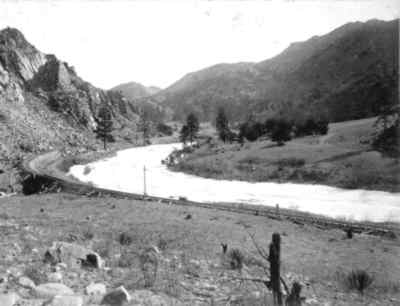
It was the poor crop, following the second spring planting that led to the final dissolution of the colony. In the fall of 1883, a year after their first appeal to the HIAS, the colonists received $2000 in removal funds. A few families took their share and relocated. Others remained, relying on support from the Denver Jewish community to see them through another harsh winter. Most of these people left soon after the second Passover, leaving only six families to plant a third crop. This crop, too, was destroyed by a spring blizzard, and it was evident, then, to continue would be futile. The colony was officially dissolved in June of 1884.
There has been much debate about why the Jewish colony at Cotopaxi did not succeed. Poor timing, poor preparation, poor weather, poor funding, the cultural and language barrier, and the role played by Emanuel Saltiel have all been questioned. If any one of these things had been different, would the colony have been a success?
In a recent paper written by a descendent of the Saltiel family, Miles Saltiel defends Emanuel Saltiel as a somewhat “rumbustious,” but well-intended benefactor. He points out that there are no other cases of successful agricultural colonies in the United States during that time period. Perhaps this is so, but if nothing else, Emanuel Saltiel influenced the placement of the colony with his letter to HIAS, extolling the virtues of Cotopaxi and by promising to provide adequate housing and equipment to enable the colonists a good start. When asked for help, Saltiel at one point simply “shrugged.”
Another lingering question regards the land that the colonists expected to eventually own through the Homestead Act. It is said the colonists were taken by wagon to Cañon City to file declarations, but these turned out to be little more than statements taken by a confused clerk which gave them no legal entitlement to the land. Because of the language barrier, it is unclear what understanding they had of the filing process or if anyone told them how to properly apply for the land.
Throughout all this, the spirit of these Russian Jews eclipsed the travesty. After the dissolution of the colony, many of them remained in Colorado and became successful farmers and ranchers in places such as Rocky Ford, Longmont, Pueblo, and Montrose. Others moved to Denver and became successful businessmen and leaders in the West Colfax Jewish community. The Cotopaxi colony itself was short-lived, but the legacy of the “experiment” has survived. The colonists of Cotopaxi proved the pioneer dictum that stepping into the unknown requires courage and faith, and while their journey did not end where they imagined, taking the first step eventually led to the new lives they desired.

Nancy Oswald is a teacher and writer living on a family ranch south of Cotopaxi where a few fragments from the colony still remain. She is the author of Nothing Here But Stones, a historical novel for ages 10 and up based on the colonists’ experiences; it was published in 2004.

